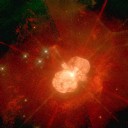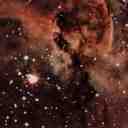 eta
Carinae
eta
Carinae Introduction
IntroductionFrom ground-based telescopes, the homunculus of eta Carinae appears as an ellipsoid roughly 18" x 10" with major along position angle 132 degrees. HST WFPC2 images resolve the ellipsoid into two roughly equal lobes (SE and NW) and an equatorial 'skirt.' Within the skirt, along the major axis is an oar-like shaped region called the `paddle.'
Our recent astrometric work (Currie et al, 1995a) using data from HST shows that the plane-of-the-sky motions in the homunculus are generally radial, linearly increase in magnitude with distance from the central star. Within the homunculus (and NN/NS knots) the measured expansion is 0.64%/year giving an average ejection date of 1839, in excellent agreement with the historical great eruption which peaked in 1843. The velocities of the outer condensations have be shown by Walborn(1978,1988) to be consistent with earlier eruptions, dating back as far as the 1300s.
Observations and Analysis have continued, using data from the WP/PC and WFPC2 of the Hubble Space Telescope as well as FORS1 and UVES of the European Southern Observatory's VLT at Paranal, Chile and ESO's ADONIS system on the 3.6 meter telescope at La Silla, Chile.
The astrometric work has continued, in particular, we have addressed the motion of the so-called "Weigelt Blobs", showing that Blob D was emitted about 1941, again, coincident with an increase in brightness by about a magnitude.
Combining the data from the HST and the VLT, we have address the photometry of the Spikes, long linear features that were emitted in 1839 but, moving at 2,000 km/sec, have proceeded far beyond the homunculus. They were studied in the theses of Liwing, Neasgaure and Svensson and reported in ESO's Messenger (Currie 2000) and workshops.
The high resolution of the UVES has allowed the spectroscopic and Doppler astrometric studies of the Weigelt Blobs. We have discovered a shell , presumably a shock wave from the 1841 Great Eruption, surrounding the homunculus. The Doppler astrometric studies also indicate an origin of about 1941 and indicate the filamentary nature of the objects, with a filament showing a constant velocity and another shown a continuous variation of the velocity, indicating deceleration.
 Return to Astro-Metrology Homepage
Return to Astro-Metrology Homepage